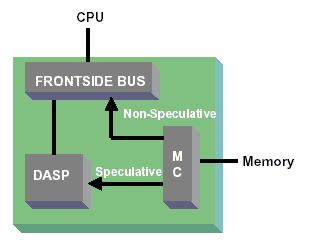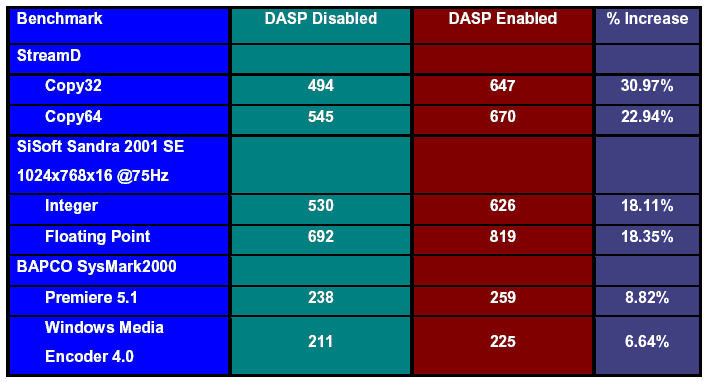Dynamic Adaptive Speculative Pre-Processor (DASP)
 NVIDIA's come up
with quite a long name to describe one of the more interesting features of the
nForce IGP. NVIDIA described it best in their tech-docs:
NVIDIA's come up
with quite a long name to describe one of the more interesting features of the
nForce IGP. NVIDIA described it best in their tech-docs:
DASP is an intelligent agent that monitors CPU requests and looks for access patterns that it can successfully predict. When it recognizes such access patterns, it exploits unused memory bandwidth to load its cache with data the CPU is expected to request later. When the CPU requests the data, it is returned to the CPU immediately rather than after waiting for the memory access. For such requests, latency is reduced from 40% to 60%. DASP is carefully engineered to make efficient use of memory bandwidth while minimizing overall latency.
Basically, DASP acts much like the hardware prefetch found on the Pentium 4 and Palomino-based Athlon 4 processors. The difference here is that the feature is implemented on the north bridge, rather than on the CPU itself. As far as we know, this is another first for a chipset. In fact, NVIDIA claims that they've got a patent pending on the technology, so unless they license it out, we won't be seeing it on other manufacturer's chipsets anytime soon.
Interestingly enough, the i860 chipset from Intel apparently has a "prefetch cache" as well, but Intel is very tight lipped about it. Whether there is any similarity to NVIDIA's DASP has yet to be determined.
Of course, DASP will be most beneficial when the memory accesses can be predicted successfully, something that is most likely to happen with sequential or streaming access. Interestingly enough, these are the types of memory accesses in which RDRAM excels.
NVIDIA claims that DASP can boost performance up to 20%, but this seems to be primarily in raw memory benchmarks where DASP is most capable of correctly predicting the memory access pattern. Real world performance benefits look to be in the range of 5-10%, depending exactly what you're doing, with larger benefits coming in applications that stream a lot of data. This is about the same as the performance boost given by hardware prefetch on the Palomino-based Athlon 4.
The table below shows the performance numbers NVIDIA has achieved with DASP. Notice how streaming applications and memory benchmarks benefit the most, while office application benchmarks still receive a tangible benefit. The Sandra STREAM benchmarks are especially interesting and are quite a bit higher than the other DDR chipsets we've tested to date.

At this point, it appears that NVIDIA arrived at their numbers with a standard Thunderbird-based Athlon, so it's unclear how much DASP will help a processor that already has hardware prefetch, such as the Palomino-based Athlon 4.










1 Comments
View All Comments
Drudy - Tuesday, June 1, 2021 - link
In order to fully equip your tablet, you need a quality provider to always stay in touch. I can advise you on the site https://vox.do/ where you can also find out about the services of international numbers with an increased tariff. I think you will find a lot of interesting details here.